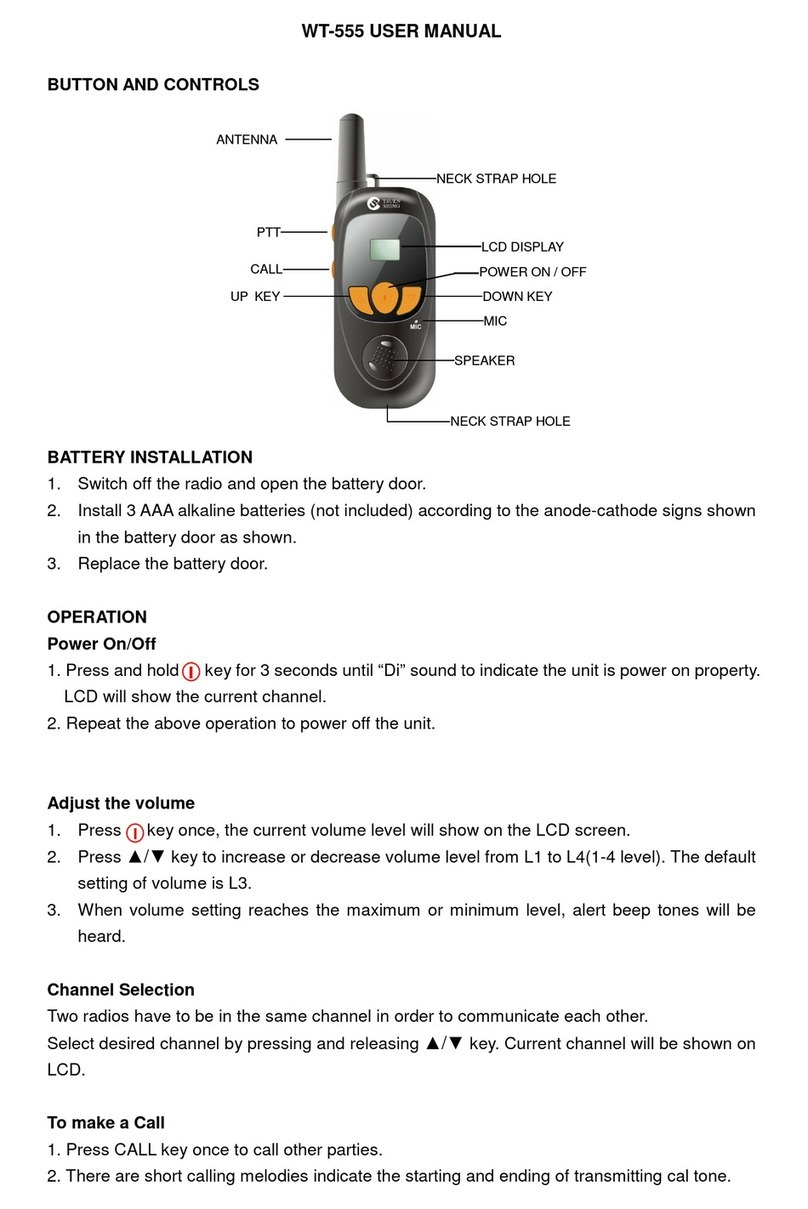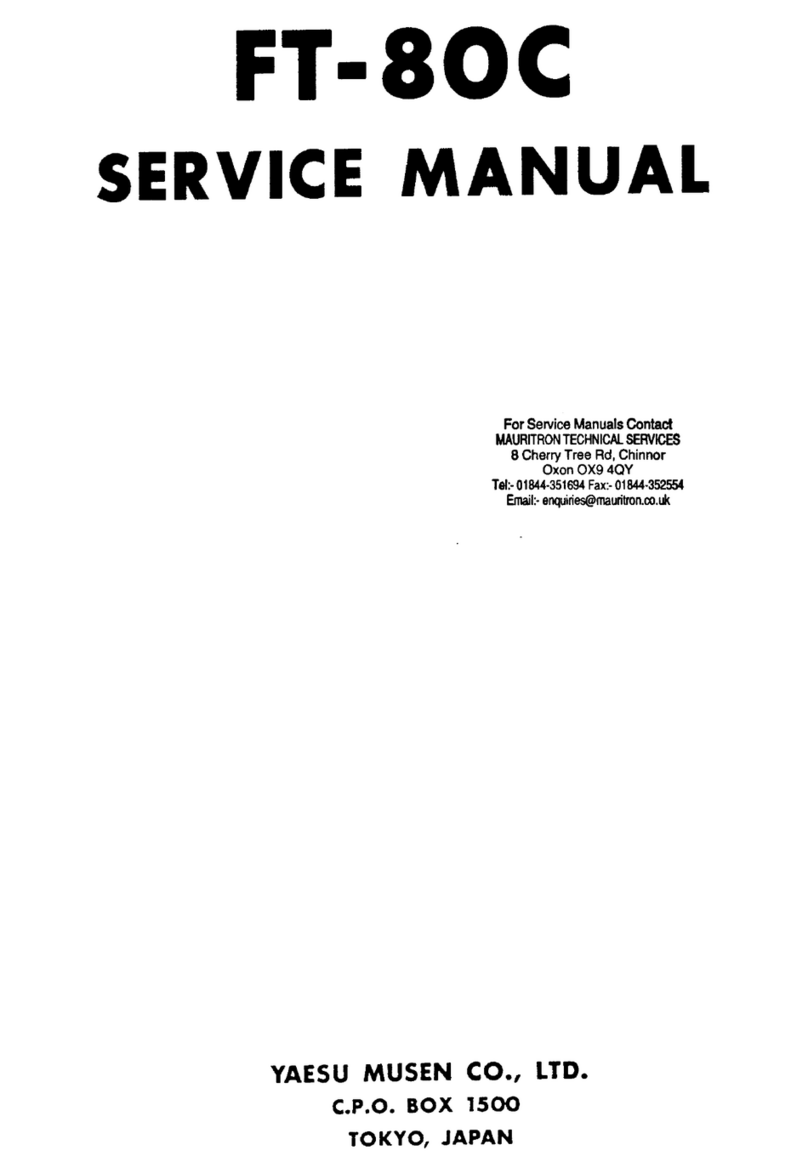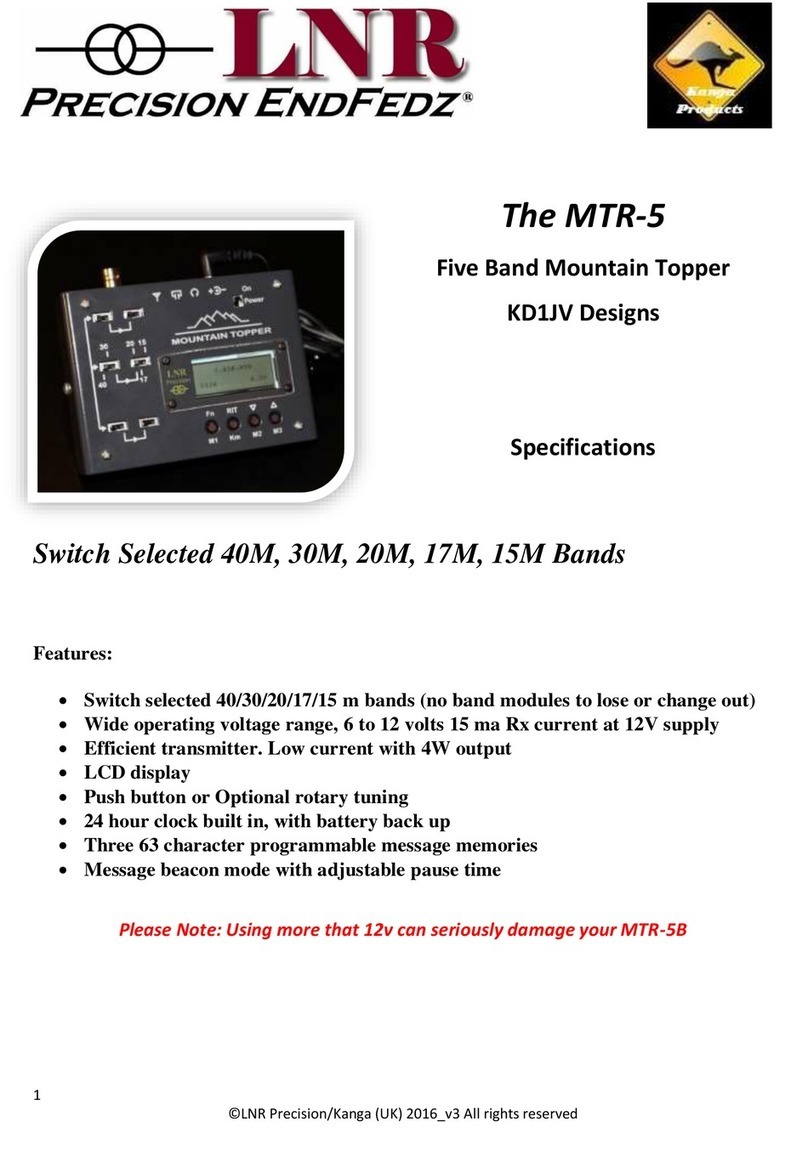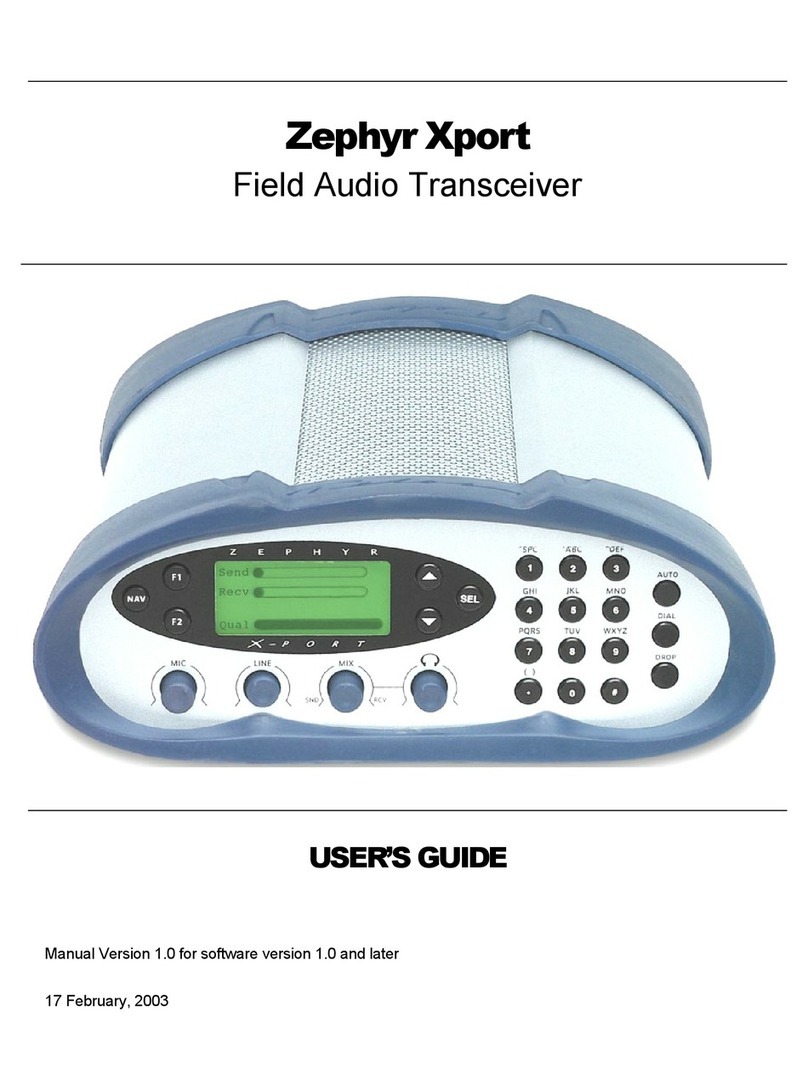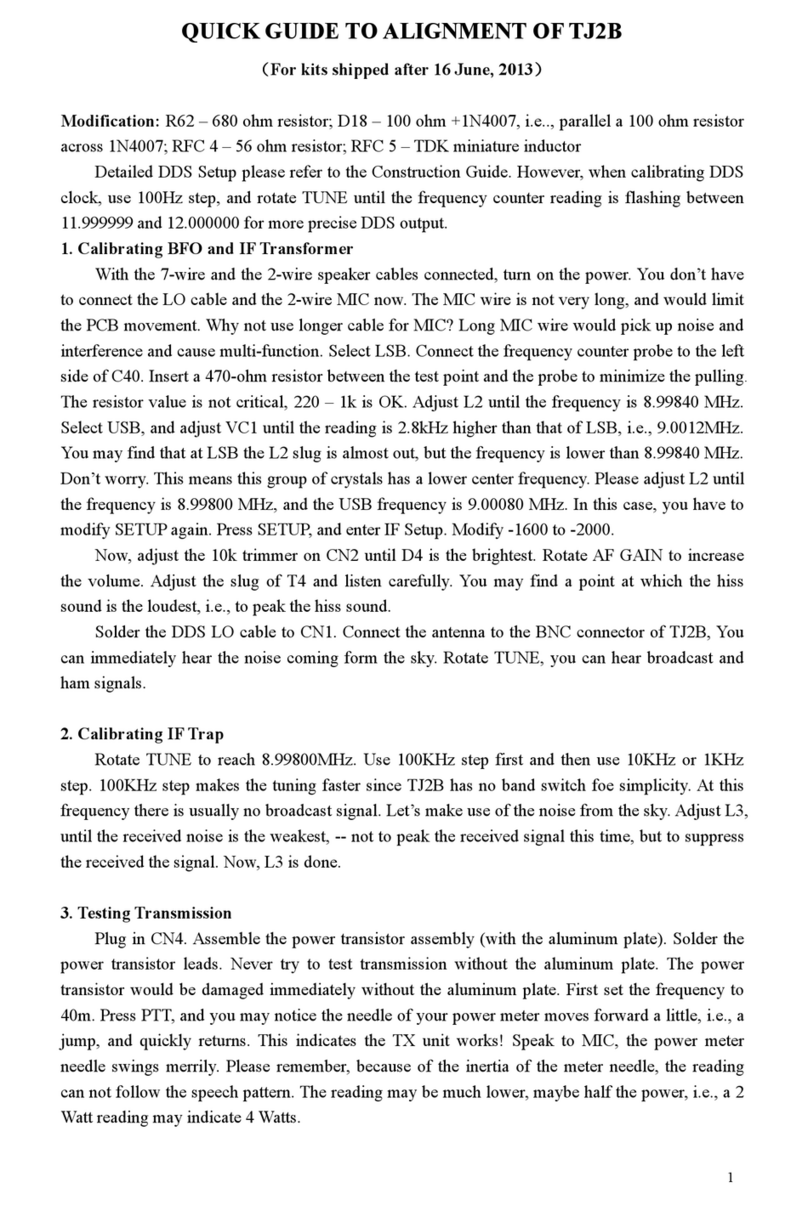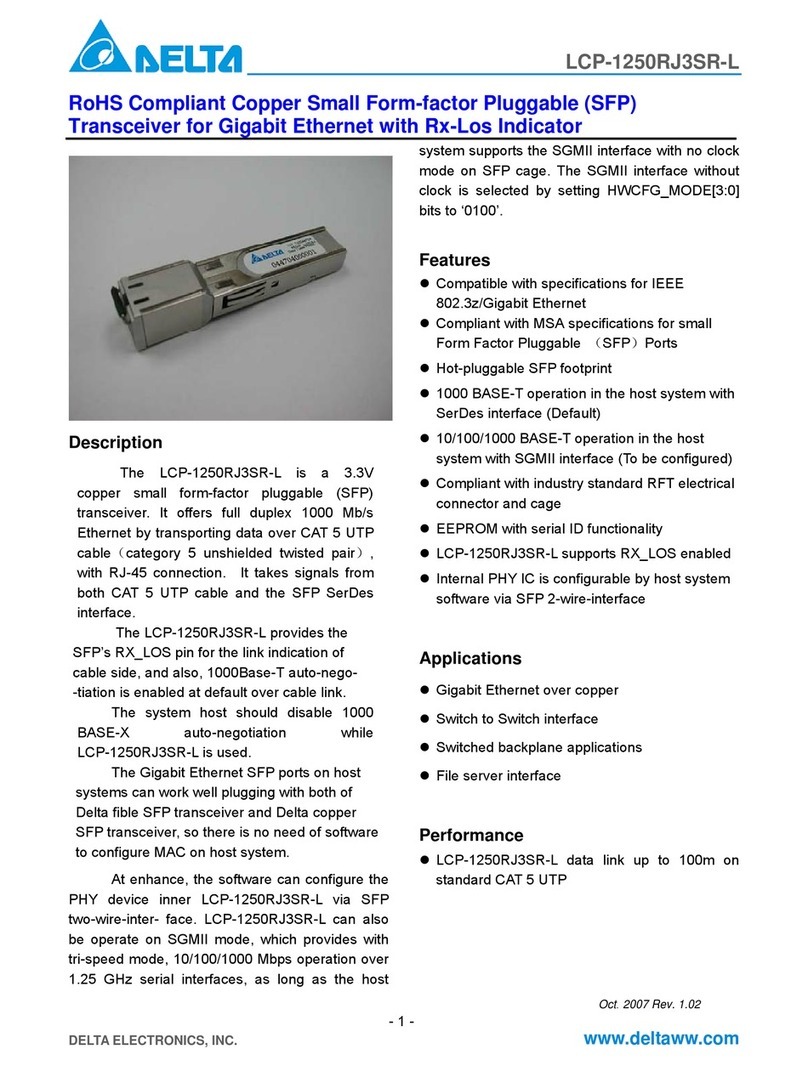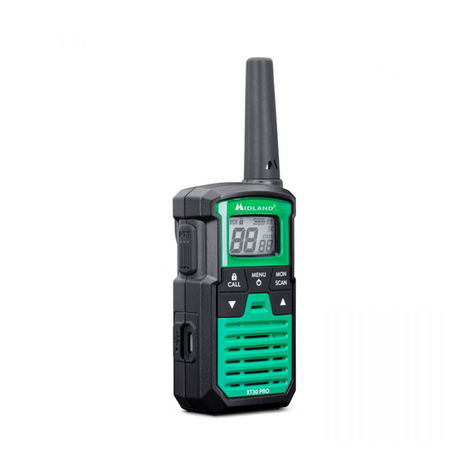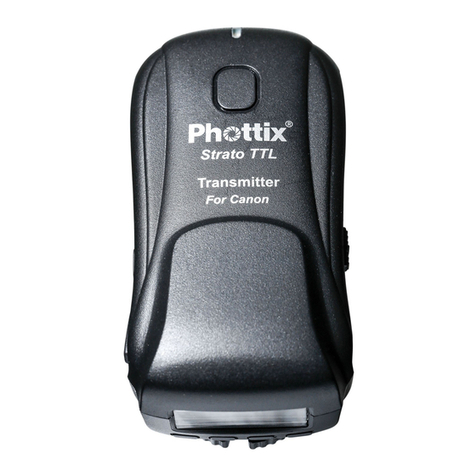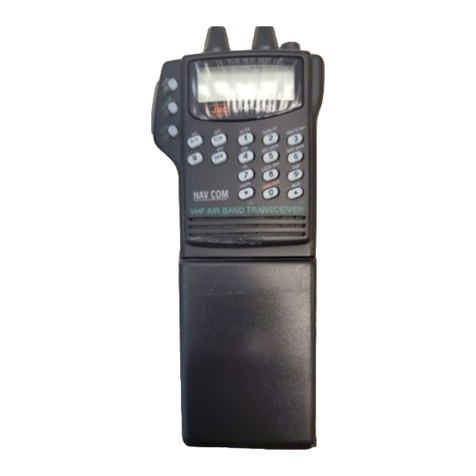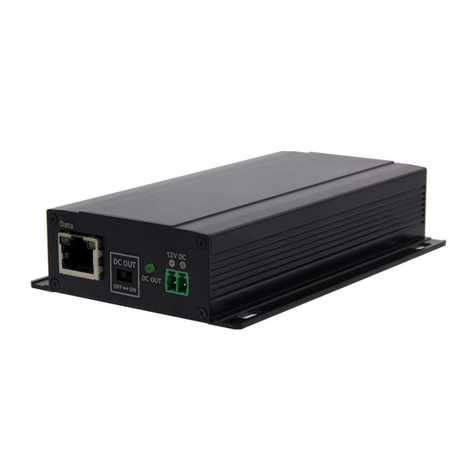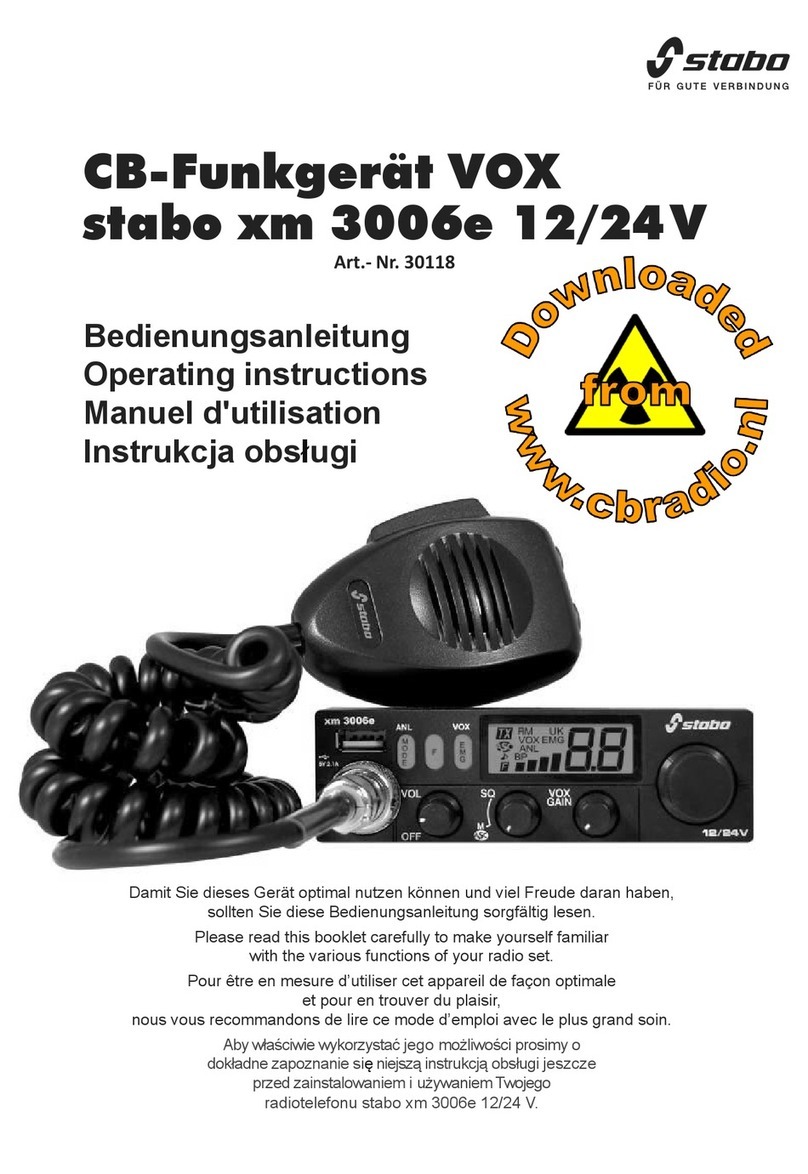Ericsson GE AEGIS EDACS M-PA User manual

Mobile Communications
AEGISTM EDACS® M-PATM
SCAN MODEL
PORTABLE RADIO
LBI38794-B
Operator’s Manual

TABLE OF CONTENTS
INTRODUCTION . . . . . . . . . . . . . . . 3
CONTROLS . . . . . . . . . . . . . . . . . 3
INDICATORS . . . . . . . . . . . . . . . . . 8
UNIVERSAL DEVICE CONNECTOR . . . 10
ALERTTONES . . . . . . . . . . . . . . . 10
OPERATION . . . . . . . . . . . . . . . . 11
POWER-UP . . . . . . . . . . . . . . . . . 11
SYSTEM/GROUP/CHANNEL
SELECTION . . . . . . . . . . . . . . . . . 11
VOICE MODES . . . . . . . . . . . . . . . 12
Clear Modes . . . . . . . . . . . . . . 12
Aegis Digital Mode . . . . . . . . . . . 13
Aegis Private And Voice
Guard Private Modes . . . . . . . . . . 13
TRUNKED MODE OPERATION . . . . . . 16
Receiving A Message . . . . . . . . . 16
Sending A Message . . . . . . . . . . 18
Emergency Operation . . . . . . . . . 19
Dynamic Regrouping . . . . . . . . . . 19
Wide Area System Scanning . . . . . . 20
TABLE OF CONTENTS (CONT.)
ScanningTrunkedGroups . . . . . . . 20
Special Calls . . . . . . . . . . . . . . 21
CONVENTIONAL MODE
OPERATION . . . . . . . . . . . . . . . . . 23
Receiving A Message . . . . . . . . . . 23
Sending A Message . . . . . . . . . . 24
Emergency Operation . . . . . . . . . 26
Scanning Conventional Channels . . . 26
OPERATINGTIPS . . . . . . . . . . . . . . 27
OPERATING RULES AND
REGULATIONS . . . . . . . . . . . . . . . 28
BATTERYPACKS . . . . . . . . . . . . . . 29
INSTALLINGTHEBATTERY PACK . . . . . 29
REMOVINGTHEBATTERY PACK . . . . . 29
CHARGINGTHEBATTERY PACKS . . . . . 30
RECHARGEABLE BATTERY PACK
DISPOSAL . . . . . . . . . . . . . . . 31
SWIVEL MOUNT REMOVAL
AND REPLACEMENT . . . . . . . . . . . . 31
INTRINSICALLY SAFE USAGE . . . . . . . 32
BATTERYPACKS . . . . . . . . . . . . 32
ACCESSORIES . . . . . . . . . . . . . 32
GLOSSARY . . . . . . . . . . . . . . . . . 34
WARRANTY . . . . . . . . . . . . . . . . . 38
NICKEL-CADMIUM BATTERY
WARRANTY . . . . . . . . . . . . . . . . . 39
This manual is published by Ericsson GE MobileCommunications Inc., without
any warranty. Improvements and changes to this manual necessitated by typographical
errors, inaccuracies of current information, or improvements to programs and/or equip-
ment, may be made by Ericsson GE Mobile Communications Inc., at any time and
without notice.Such changes will be incorportated into new editions of this manual.No
part of this manual may be reproduced or transmitted in any form or by any means,
electronic or mechanical, including photocopying and recording, for any purpose, without
the express written permission of Ericsson GE Mobile Communications Inc.
Copyright © May, 1992, Ericsson GE Mobile Communications Inc.
2

INTRODUCTION
The Aegis EDACS M-PA Scan model portable
radio is a high-performance two-way radio that pro-
vides clear voice, Aegis digital, and Aegis private
communications. The radio is also compatible with
Voice Guard® communication systems. Personality
programming allows maximum integration flexibility
into EDACS and conventional radio systems.
The radio must be equipped with the encrypt/de-
cryptoption beforeoperationinAegisprivateorVoice
Guard modes is possible.This option allows the radio
to communicate using highly secure state-of-the-art
Aegis and Voice Guard encryption and decryption
techniques.
Operating controls on the radio include a ro-
tatable system/group/channel control knob, rotatable
volume control, 4-button keypad, push-to-talk, emer-
gency and monitor buttons. The on/off power switch
for the unit is located on the removable battery pack.
The 8-digit alphanumeric liquid crystal display
(LCD) on the front of the radio displays the operating
status of the radio. This backlit display also has
sixteen status flags that indicate various operating
conditions such as private communications enabled,
transmitter on, scanning, or emergency mode en-
abled.
Theexact operationof yourradiowillvarydepending
uponthemodeofoperation,theradio’sprogramming,
and the particular radio system. Consult your radio
system’srepresentativeforparticularfeaturesthatare
programmed into yourradio.
CONTROLS
ON/OFF SWITCH
TheON/OFFSWITCHislocatedonthebatterypack.
Sliding this switch up will supply power to the radio
from the battery pack. An audible click will be heard
and the "ON" indicator will be exposed. When the
radio is turned on, it will perform a power-up self test
andthenresumeoperationonthepreviousoperating
system, group or channel as displayed in the LCD.
Sliding the switch down will turn the radio off.
3

VOLUME CONTROL KNOB
The VOLUME CONTROL KNOB is a rotatable
control on the top of the radio used to adjust the
receiver’s audio level in the speaker. Rotating this
knob in a clockwise direction will increase the audio
level. Counter-clockwise rotation will decrease the
audiolevel. Minimumlevelsmaybeprogrammedinto
the radio to prevent missed calls due to too low of a
volume setting.
CONTROL KNOB
The rotatable 16-position CONTROL KNOB located
on the top of the radiomay be programmed to select
trunked groups and conventional channels or it may
be programmed to select systems. See SYS-
TEM/GROUP/CHANNEL SELECTION for details.
A stop plate may be installed under the knob to limit
themaximumnumberofpositionstolessthansixteen
(16). It is normally factory installed for fifteen (15)
positions.
PTT BUTTON
Pressing the PTT BUTTON on the side of the
radio will enable the radio’s transmitter. The "TX"
statusflagin thedisplaywillturnonwhen theradiois
transmitting. Releasing the PTT BUTTON will return
operation to receive mode.
When operating in a trunk system, the radio may
beprogrammedtoautomaticallytransmit(withoutthe
operator pressing the PTT BUTTON) to maintain
communication with the site controller. The "TX"
status flag will turn on whenthe radio is transmitting.
MONITOR BUTTON
Trunked Mode
When operating in trunked mode, pressing the
MONITOR BUTTON after an individual call has been
received will return the radio to the group call mode.
The radio willnot respond on an individualbasis, but
will then transmit groupcalls when thePTTBUTTON
ispressed. Theradiowillalso automaticallyreturnto
the group call mode after the programmed call-back
time-out period expires.
In addition, this button is used totoggle between
group and regroup settings if the Dynamic Regroup-
ingmode(withdeselectcapability)hasbeenenabled
by the site controller.
4

Figure 1 - Aegis EDACS M-PA Scan Model Radio
5

Conventional Mode
Whentheradioisoperatinginconventionalmode
the MONITOR BUTTON is used to unsquelch the
receiver. If programmed for the selected channel, it
will also toggle Channel Guard (CG) and/or Type 99
(T99) signalling on and off.
Momentarily pressing the MONITOR BUTTON
will unsquelch the receiver. If programmed, pressing
and holding the button for atleast one (1)second will
toggleCGand/orT99signallingonoroff. AfteraT99
callhasbeenreceived,pressingtheMONITORBUT-
TON will reset the radio for the next call. Note: Se-
lecting another channel will turn CG and T99
signalling back on if programmed for the channel.
EMERGENCY BUTTON
When operating in trunked mode, pressing and
holdingtheredEMERGENCYBUTTONontopofthe
radio for approximately one (1) second will initiate an
emergency call with voice operation on the pro-
grammed home group. If no home group is pro-
grammedintotheradio,voiceoperationwillbeonthe
selected group.
In conventional mode, initiating an emergency
call by pressing the EMERGENCY BUTTON will
causetheradiototransmitGE-STARsignallingonthe
programmed emergency channel. If no emergency
channelisprogrammed,GE-STARwillbetransmitted
on the selected channel.
STEP BUTTON
The STEP button located on the keypad may be
programmed to select trunked groups and conven-
tional channels or it may be programmed to select
systems.SeeSYSTEM/GROUP/CHANNEL SELEC-
TION for details.
Figure 2 - Keypad
6

STEP is also used to scroll through the pro-
grammed special call table when the special call
mode is enabled.
SCAN BUTTON
Pressing the SCAN button on the keypad will toggle
scan operation on and off. When the radio is scan-
ning,the"SCN"statusflaginthedisplaywillshowand
all groups/channels on the scan list in the current
system will be scanned.
SPECIAL CALL BUTTON
When operating in trunked mode, pressing SPC
will switch operation from the group select mode to
the special call mode. The last selected special call
will be displayed.
While in special call mode, the next programmed
special call may be selected by pressing STEP.
Pressing 2nd then STEP will select the previous
programmed special call. The caller’s ID of the last
received individual call and the last received group
call on the selected group are also selectable using
this method. See Special Calls for details.
2nd FUNCTION BUTTON
Two (2) of the buttons on the keypad are dual-
function buttons. Press and release the blue 2nd
function button to shift keypad selection to the A/D
andPVTbuttons. The followingparagraphsdescribe
operation of the shifted buttons.
ADD/DELETE BUTTON (Shifted SCAN Button)
When in trunked mode, pressing and releasing
2ndandthenpressingA/D (shiftedSCANbutton)will
add the selected group to the scan list if it is not
already on the list. Repeating this sequence will
delete the group from the list. When the selected
group is on the scan list,the "S" status flag willshow
in the display.
Inconventionalmode,pressingandreleasing2nd
and then pressing A/D will scroll the selected chan-
nel’s scan priority between non-priority scan ("S"
status flag), priority-two scan ("2" status flag), prior-
ity-one scan ("1" status flag) and no scan (no status
flags).
7

Scan must be turned off before groups or chan-
nels can be added to or deleted from the scan list.
See SCAN BUTTON for details.
PRIVATE BUTTON (Shifted SPC Button)
Private transmit mode is enabled or disabled by
pressing and releasing 2nd and then pressing PVT
(shifted SPC button). When enabled, the "PVT"
status flag in the display will turn on.
If the radio is programmed for forced private op-
eration,"FRCDPVT"willbedisplayedwhen2nd-PVT
is pressed; private transmit mode is not disabled. If
the selected group orchannel is not programmedfor
privateoperation,"PVTDIS"willmomentarilyshowin
the display when 2nd-PVT is pressed; the radio will
notchangetoprivatemode. SeePRIVATE COMMU-
NICATIONS for additional details.
KEYPAD LOCK FEATURE
To prevent accidental activationof the buttonson
the keypad, simultaneously press SCANand SPC to
lockthekeypad;"LOCKED"willbedisplayedmomen-
tarily. To unlock the keypad, press SCANand SPC a
secondtime;"UNLOCKED"willbedisplayedmomen-
tarily.
INDICATORS
Theradio’sliquidcrystaldisplay(LCD)locatedonthe
frontpanelhaseight(8)alphanumericcharactersand
sixteen(16)statusflags.Thisdisplayprovidesindica-
tions of the current operating system, group or chan-
nel and it displays various other messages such as
special call ID names or numbers, and telephone
interconnect numbers.
LCD backlighting will turn on for a short period any-
time an active button is pressed or the CONTROL
KNOB is rotated. Backlighting may be programmed
to remain off at all times.
Figure 3 -Liquid Crystal Display
8

Thesixteen(16)statusflagslocatedalongthetop
and bottom of the display indicate operating modes
and conditions as follows:
EMG EMerGency mode - On indicates an
emergency call has been initiated by the
user. Flashing indicates an emergency
call has been received.
NC No Control channel - On indicates the
radio is not receiving the trunked control
channel. Flashing indicates the trunked
system is in a failsoft condition (supervi-
sory radios only).
HI HIgh power transmit - On indicates the
selectedsystemorchannelhasbeenpro-
grammed for high power transmit opera-
tion. Off indicates low power transmit.
MSG MeSsaGe - Flashing indicates an individ-
ualcallhasbeenreceived(trunkedmode).
T99 Type99 tonedecode- OnindicatesType
99 tone decoding is enabled on the se-
lected conventional channel. Flashing in-
dicates a T99 selective call has been
received and the radio must be reset to
receive another T99 call.
CNV CoNVentional mode - On indicates the
radio is operating in the conventional
mode.
SPC SPecial Call mode - Onindicatesthespe-
cial call mode has been enabled (trunked
mode).
PVT PriVaTemode-Onindicatesprivatemode
is enabled and the radio will transmit en-
crypted messages on the selected group
or channel. Flashing indicates an en-
crypted message is being received.
TX Transmitter enabled - On when the radio
is transmitting.
BSY BuSY - When in trunked mode, on indi-
cates the radio isreceiving a call; flashing
indicates a call has beenqueued. In con-
ventional mode, on indicates a carrier is
being received.
CG Channel Guard - On indicates Channel
Guard encode/decode is enabled on the
selected conventional channel.
BAT BATtery low - On indicates the battery
pack’s charge is low.
S Scan list - On indicates the selected
group/channel is on the scan list.
9

1priority 1 - On indicates the selected con-
ventional channel is designated as the
priority-one scan channel.
2priority 2 - On indicates the selected con-
ventional channel is designated as the
priority-two scan channel.
SCN SCaN mode - On indicates the radio is
scanning.
UNIVERSAL DEVICE CONNECTOR
TheUniversal DeviceConnector (UDC) is located on
the side of the radio just above the PTT and MONI-
TOR BUTTONS. This connector provides connec-
tions for the external accessories such as a headset,
aspeaker-mike,oranemergencylanyard. Whenthe
radio is locked in a vehicular charger/repeater the
UDC provides the audio and control connections
betweentheradioandthevehicularcharger/repeater.
TheUDCisalsousedby the maintenance personnel
when the radio is programmed.
ALERT TONES
The radio sounds five (5) basic alert tones or "beeps"
to indicate various operating conditions. Alert tones
may be programmed to remain off at all times.
•500 Hz Tone –trunked failure tone - sounds
whenatrunkedfailurehasoc-
curred(calldenied,failedcon-
firmation)
–lowbattery-soundswhenthe
battery pack’s charge is low
•800 Hz Tone –private mode disabled - on a
conventionalchannel,sounds
when the PTT BUTTON is
pressed if private transmit
mode has previously been
disabled
•1000 Hz Tone –alert tone - sounds when a
buttonispressedandastatus
change occurs
–channelaccesstone-sounds
when a trunked channel has
been assigned and it is clear
to talk
•1200 Hz Tone –private mode - channel ac-
cess tone - sounds when the
radio is inthe private transmit
mode, a trunked channel has
been assigned and it is clear
to talk
•2500 Hz Tone –call queued tone - sounds
whenatrunkedcallisqueued
10

OPERATION
POWER-UP
After the battery pack and antenna have been
installed, turn the radio on by sliding the ON/OFF
SWITCH on the battery pack up. After the radio has
completedapower-upself-test,itwillbeginoperation
onthelastoperatingstateasdisplayedin theLCD. If
programmed on, the power-up alert tone (beep) will
be heard.
Iftheradiowaspreviouslyoperatingin atrunking
systemandcommunicationwiththissystem’s control
channel can not be established, the "NC" status flag
will turn on. This may occurif, for example, the radio
isoutof rangeoftheprevioustrunkingsite. Itmaybe
necessary move to another location, select another
trunking system, or a conventional channel.
SYSTEM/GROUP/CHANNEL SELECTION
The radio may be programmed with one of two
different system/group/ channel selection modes as
follows:
•Systems are selected with the STEP button;
groups and channels are selected with the
CONTROL KNOB.
or
•Systems are selected with the CONTROL
KNOB; groups and channels are selected with
the STEP button.
STEP Button Programmed For System Selection
CONTROL KNOB Programmed For
Group/Channel Selection
System Selection
PressandreleaseSTEPtoselectthenextsystem
programmedintotheradioasindicatedinthedisplay.
Toselecttheprevioussystem,pressandrelease2nd
andthenpressSTEP. HoldingdownSTEPwillcause
the radio to automatically scroll through the system
list.
Uponreachinganendofthesystemlist,theradio
maybeprogrammedtostopselectionorwraparound
(go from one end to the other).
11

Group/Channel Selection
After the desired system is selected with the
STEP button, rotate the CONTROL KNOB to the
desired trunked group or conventional channel as
indicated in the display. A stop-plate may be placed
undertheknobwhichwilllimitthemaximumpositions
to less than sixteen (16).
CONTROL KNOB Programmed For System
Selection
STEP Button Programmed For Group/Channel
Selection
System Selection
Rotate the CONTROL KNOB to the desired sys-
tem as indicated in the display. A stop-plate may be
placed under the knob which will limit the maximum
positions to less than sixteen (16).
Group/Channel Selection
After the desired system is selected with the
CONTROL KNOB, pressandreleaseSTEPto select
the next trunked group or conventional channel pro-
grammedintotheradioasindicatedinthedisplay. To
select the previous group or channel, press and re-
lease2ndandthenpressSTEP. HoldingdownSTEP
willcausetheradiotoautomaticallyscrollthroughthe
group/channel list.
Upon reaching an end of the group/channel list,
the radio may be programmed to stop selection or
wrap around (go from one end to the other).
VOICE MODES
Each system (trunked or conventional) in the
radio is programmed for either Aegis or Voice Guard
communications. Aegis programmed systems have
three (3) different voice modes: clear, digital and
private. Voice Guard systems have two (2) voice
modes: clear and private. The voice modes are pro-
grammed on a per-group basis within each trunked
system and on a per-channel basis within each con-
ventional system.A radio must be equipped with the
encrypt/decrypt option before it will operate in Aegis
private orVoice Guard modes.
Clear Modes
Aegis clear and Voice Guard clear modes are
identicalvoicemodesinwhichtheradiotransmitsand
receivesonlyclear(analog)voicesignals.Theseana-
log signals are non-digitized and non-encrypted.
12

Clearmodetransmissionscanbeeasilymonitoredby
unauthorized persons. Groups and channels pro-
grammed for clear operation cannot transmit or re-
ceive Aegis digital or private messages.
Aegis Digital Mode
Aegisdigitalmodeallowstheradiototransmitand
receive digitized voice signals. Aegis digital signals
provide improved weak signal performance and they
cannot be easily monitored with a standard receiver.
Groups and channels programmed for Aegis digital
operation transmit only digital signals and they can
receive clear and digital signals.In other words, with
a certain group or channel selected, the operator
cannot change fromthe digital transmit mode butthe
radio will receive clear or digital signals.Private (en-
crypted) messages cannot be received when the
radio is in Aegis digital mode.
Aegis Private And Voice Guard Private Modes
(Optional)
TheAegisprivateandVoiceGuardprivatemodes
allow the radio to transmit and receive encrypted
messages.Tooperateinthesevoicemodes,theradio
TRANSMIT/RECEIVE MODE COMPATIBILITY
FOR AEGIS OPERATION
GROUP/CHANNEL
PROGRAMMING
(TRANSMIT)
RECEIVE CAPABILITY
CLEAR DIGITAL PRIVATE
CLEAR Yes No No
DIGITAL Yes Yes No
PRIVATE Yes No Yes *
*assumes the proper cryptographic key is loaded
TRANSMIT/RECEIVE MODE COMPATIBILITY
FOR VOICE GUARD OPERATION
GROUP/CHANNEL
PROGRAMMING
(TRANSMIT)
RECEIVE CAPABILITY
CLEAR PRIVATE
CLEAR Yes No
PRIVATE Yes Yes *
* assumes the proper cryptographic key is loaded
13

must be equipped with the optional encrypt/decrypt
feature and the transmitting and receiving unitsmust
have identical cryptographic keys.
Aegis transmissions cannot be received by a
radio set to receive a Voice Guard transmission.Ac-
cordingly, a Voice Guard transmission cannot be re-
ceivedbyaradiosettoreceiveanAegistransmission.
Cryptographic keys are transferred into the radio
using a cryptographic Keyloader. Up to seven (7)
different cryptographic keys, numbered 1 - 7, can be
transferred from a Keyloader and stored in the radio.
An individual key is automatically selected on a per-
group/channel basis according to the radio’s pro-
gramming. Groups and channels within Aegis
systems can be programmed for keys 1 - 6.Groups
and channels within Voice Guard systems can be
programmed for keys 1 - 7.
DES radios require a DES Keyloader (option
V4025).Operating details on the DES Keyloader are
contained in LBI-31541. VGE radios require a VGE
Keyloader (option V4028).See LBI-31685foroperat-
ing details on the VGE Keyloader.
When operating on a group or channel pro-
grammed for private mode, all transmissions will be
private transmissions and the radio will receive clear
and private signals. The "PVT" status flag in the
display turns on when the private mode is enabled.If
the selected group or channel is programmed for
autoselect capability, the mode may be toggled be-
tween private and clear using the 2nd - PVT buttons
(shifted SPC).Radios programmed for forced private
operationdonotallowachangeofthetransmitmode;
the PVT button does not function.
Transferring Keys Into The Radio
Thefollowingprocedureoutlinesbasickey trans-
ferring steps.
1. Turn the radio off.
2. PlugthemodularconnectoroftheKeyloader
cable into the Keyloader’s modular jack.
Before private messages can be sent or
received, one or more cryptographic keys
must be transferred into the radio from the
Keyloader.
NOTE
14

3. Connect the Keyloader cable tothe UDC on
the radio.
4. PressthePWRbuttonontheKeyloaderand
wait for the Keyloader to display "MASTER
MODE".
5. Press the TRN button on the Keyloader. If
necessary, select a different cryptographic
key to be transferred into the radio.
6. Turn the radio on. The display should read
"KEY LOAD".
7. Press the EXE button on the Keyloader to
transfer the key. The Keyloader will display
"GOOD 1.x TRANSFER" where "x" is the
selected cryptographic key number.
8. Disconnect the cable from the radio’s UDC.
A single beep will be heard from the radio’s
speakerifthepower-upalerttoneisenabled.
The radio will change to the selected group
or channel as indicated in the display.
Key Zero
All cryptographic keys can be zeroed or "dumped"
when the radio is on by simultaneously pressing the
STEPand2ndbuttonsforatleastonesecond. When
the key(s) have been zeroed, the radio will display
"KEY ZERO" and it will emit a series of beeps. If the
cryptographic key(s) are zeroed, one or more keys
must betransferred into theradio from the Keyloader
before private communications may continue.
The cryptographic keys stored in DES version radios
can also bezeroedusingtwo (2) additional methods.
Removing the battery pack for several minutes (typi-
cally three), ordisassembling the radiowill zero allof
thecryptographickeysstoredin aDESversionradio.
Receiving An Encrypted Message
When receiving, the radio automatically switches be-
tween clear or private operation. If the transmission
beingreceivedisanencryptedtransmission,itwillbe
decrypted,the"PVT"statusflagwillflash,thereceiver
will unsquelch, and the message will be heard in the
speaker. For this to occur, the selected group or
channel must be programmed for private operation
andthecorrectcryptographickeymustbeloadedinto
the radio.
15

Transmitting An Encrypted Message
1. Select the desired group or channel.
2. Toggle operation to private transmit by
pressing and releasing 2nd and then press-
ingPVT(shiftedSPCbutton). Whenprivate
transmit mode is enabled, the "PVT" status
flag in the display will turn on.
If a group or channel is not programmed for
private mode operation,"PVT DIS" will mo-
mentarilyshowinthedisplayifanattemptis
made to enable private transmit mode. It is
not possible to operate on this group/chan-
nel in private mode.
If the radio is programmed for forced private
transmit operation, "FRCD PVT" will mo-
mentarilyshowinthedisplayifanattemptis
made to disable private transmit mode. It is
not possible to transmit on this group/chan-
nel in clear mode.
3. Continue with standard transmission proce-
dures. In conventional mode, ifa channel is
programmed for private operation and pri-
vate transmit mode has been disabled, the
radio will sound an alert tone when the PTT
BUTTON is pressed to warn of the clear
(non-encrypted) transmit mode.
TRUNKED MODE OPERATION
Digital trunking provides fast communication ac-
cess. In this mode the operator selects a communi-
cation system and group and the communication
channelisallocatedthroughdigitalsignallingwiththe
site. The following operation is applicable to clear,
digital and private operation unless otherwise noted.
Receiving A Message
1. Slide the ON/OFF SWITCH on the battery
packtotheonposition. Theradiowillinitiate
andcompletethepower-upself-testthenthe
system’s name and "NC" status flag will be
displayed until a control channel is located.
When the control channel is located, the
"NC" status flag disappears and the group
name is displayed.
2. Adjust the VOLUME CONTROL to an ap-
proximate mid-range position.
16

3. Select the desired system and group using
the STEP button and CONTROL KNOB.
See the SYSTEM/GROUP/CHANNEL SE-
LECTION operating procedures for details.
The display indicates the selected group.
4. Theradioisnowreadytoreceivemessages.
5. GROUP CALL - When a group call is re-
ceived, the radio unsquelches on the as-
signed channel and the "BSY" status flag
turnson. Thegroupnameortheoriginator’s
ID (depending on programming) is dis-
played. Adjust the volume as necessary.
INDIVIDUAL CALL - If an individual call (a
call directed to only one radio) is received,
the radio will unsquelch on the assigned
channel and the "BSY" status flag will turn
on. "*INDV*", originators ID, or the caller’s
name (if programmed) is displayed and the
"MSG" status flag flashes. Adjust the vol-
ume as necessary.
Responding to an individual call prior to the
programmedcall-backtime-outwillautomat-
ically direct the transmission to the originat-
ing unit.
The "MSG" status flag will remain flashing
even after the individual call time-out period
expires. PresstheSPCbutton(SPecialCall)
tocalltheoriginatingunitback. Theorigina-
tor’sIDornamewillbedisplayed. Followthe
procedures for sending a special call.
ENCRYPTED MESSAGE - If the transmis-
sion being received is an encrypted trans-
mission and the selected group is
programmed for private operation and the
correct cryptographic key is loaded into the
radio, then the receiver will unsquelch, the
"PVT" status flag will flash and the private
message will be heard in the speaker. The
radio automatically switches between clear
orprivateoperationwhenitisreceivingona
group or channel programmed for private
operation.
17

Sending A Message
1. Turntheradioon,setthereceiveaudiolevel
and select the desired system and group.
2. When private transmit mode is enabled, the
"PVT" status flag in the display will turn on.
Toggle transmitoperation toprivateor clear,
as desired, by pressing and releasing 2nd
andthenpressingPVT(shiftedSPCbutton).
3. Observe the display for the absence of the
"BSY" status flag to ensure no one is trans-
mitting on the selected group.
4. PressandholdthePTTBUTTON. Theradio
will perform the necessary signalling re-
quired to obtain a communication channel.
5. When the channel has been acquired, the
"TX" and "BSY" status flags are displayed
and the channel access alert tone (one
beep) is heard.
6. Hold the radio approximately three inches
from your mouth and speak into the micro-
phone in a normal voice.
If a group is not programmed for private
mode operation, "PVT DIS" will momentar-
ily show in the display if an attempt is
made to enable private transmit mode. It is
not possible to operate on this group in
private mode
If the radio is programmed for forced pri-
vate operation,"FRCDPVT"willmomentar-
ily show in the display if an attempt is
made to disable private transmit mode. It is
notpossibletotransmitonthisgroupinclear
mode.
If a group programmed for private operation
hasbeenselectedandthereisnokeyinthe
radio for the selected group, "NO KEY x"
(where “x” is the key number) will peri-
odicallyflashinthedisplay. Ifatransmission
is attempted, "NO KEY x" will show in the
display and the radio will emit a series of
beeps and will not transmit.
NOTES
18

7. Release the PTT BUTTON when the trans-
mission is complete. If the transmission ex-
ceeds the programmed Carrier Control
Timer limit, the radio will unkey and analert
tone will sound.
8. Listen for a reply.
Emergency Operation (Trunked Mode)
Receiving An Emergency Call
If the radio receives an Emergency Channel As-
signment in trunked mode, an alert tone sounds and
the"EMG"statusflagstartsflashing. Followstandard
emergency procedures.
Sending An Emergency Call
1. To enable an emergency transmission,
press and hold the EMERGENCYBUTTON
(small red button near antenna) for approxi-
mately one second. The radio transmits an
emergency message until an Emergency
Channel Assignment is received. Upon re-
ceipt,the"EMG"statusflagturnsonandthe
radiobeginsoperationontheselectedgroup
or the home group, depending upon pro-
gramming.
2. Press the PTT BUTTON and speak into the
microphone in a normal voice.
3. Release the PTT BUTTON when the trans-
mission is complete and listen for a reply.
Dynamic Regrouping
DynamicRegroupingisafeaturewhichallowsthe
SystemManagertodynamicallyprogramnewgroups
into selected radios. Upon development of the re-
groupingplan,thesitecontrollersendseachradiothe
regroup plan number, knob setting(s), and acti-
vate/deactivate commands.
When the radio is regrouped, it will alert the user
and the display will indicate "REGRP nn" (nn = 01 -
08 depending upon the CONTROL KNOB setting).
If the regroup plan has deselect capability active
on the selected system, press the MONITOR BUT-
TONtotogglebetweenthegroupandregroupmodes.
19

Private mode Dynamic Regrouping operates as
follows:
•Whentheradioisregrouped,allregroupswill
initially operate in clear mode.
•When regrouped, the operator may toggle
between private and clear mode by pressing
2nd-PVT. Thereisno forcedprivateregroup
mode.
•Regroup operation always uses the system
cryptographic key.
•Iftheradioisprogrammedfordeselectcapa-
bility, pressing the MONITOR BUTTON will
return operation to the programmed groups
in the radio, and to private or clear mode as
the radio is programmed. Pressing the
MONITORBUTTONasecondtimewillreturn
operationto the regroupmodeandprivateor
clearmode astheradiowaspreviouslyoper-
ating.
Wide Area System Scanning
M-PA radios may be programmed for wide area
system scan operation for multi-site applications.
Upon the loss ofthe currently selected system’s con-
trol channel, radios may be programmed to automat-
ically scan the control channels of up to six other
systems. If a new control channel is found, the radio
willswitchtothenewsystemandsoundanalerttone.
Group selection may change upon switching to the
new system.
The radio may also be programmed for priority
wide area system scan. A priority system may be
assigned to each system programmed into the radio.
Radios programmed in this manner will scan the
priority trunked system’s control channel once every
one,two, threeorfourminutes(programmable). This
priority scan timer is reset each time the PTT BUT-
TON is pressed.
Scanning Trunked Groups
Groupswhichhavebeen previously added tothe
scanlistonapersystembasismaybescanned. Each
system’s scan list is retained in memory when the
radio is turned off or when the battery pack is re-
moved.
The radio will not scan when the emergency
mode is enabled ("EMG" status flag is on).
Thefollowingproceduresoutlinescanoperations
fortrunkedgroups. Seetheconventionalmodeoper-
20
Table of contents
